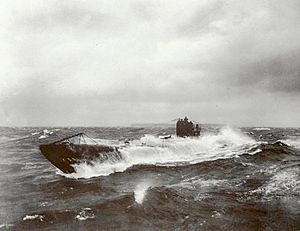SM UB-109 facts for kids

UB-148 at sea, a U-boat similar to UB-109.
|
|
Quick facts for kids History |
|
|---|---|
| Name | UB-109 |
| Ordered | 6/8 February 1917 |
| Builder | Blohm & Voss, Hamburg |
| Cost | 3,714,000 German Papiermark |
| Yard number | 316 |
| Launched | 7 July 1917 |
| Commissioned | 31 December 1917 |
| Fate | sunk by mine on 29 August 1918 at 51°3′N 1°44′E / 51.050°N 1.733°E |
| General characteristics | |
| Class and type | German Type UB III submarine |
| Displacement |
|
| Length | 55.30 m (181 ft 5 in) (o/a) |
| Beam | 5.80 m (19 ft) |
| Draught | 3.70 m (12 ft 2 in) |
| Propulsion |
|
| Speed |
|
| Range |
|
| Test depth | 50 m (160 ft) |
| Complement | 3 officers, 31 men |
| Armament |
|
| Service record | |
| Part of: |
|
| Commanders: |
|
| Operations: | 3 patrols |
| Victories: | 7 merchant ships sunk (14,092 GRT) |
UB-109 was a German U-boat (a type of submarine) used by the German Imperial Navy during World War I. The letters "SM" in its name stand for "Seiner Majestät," which means "His Majesty's" in German. So, SM UB-109 means "His Majesty's Submarine UB-109."
This U-boat officially joined the German Imperial Navy on December 31, 1917. Sadly, UB-109 was sunk by an underwater mine in the English Channel on August 29, 1918. Mines are like underwater bombs that explode when a ship touches them. Today, if you look at the area where it sank, near the Dover Barrage (a line of defenses set up during the war), you can see its wreck broken in half on the seabed.
Building a U-boat: UB-109's Construction
UB-109 was built by a company called Blohm & Voss in Hamburg, Germany. It took almost a year to build. The submarine was launched into the water on July 7, 1917. This is like a ship's birthday, when it first touches the water. Later that same year, it was officially put into service under the command of Kurt Ramien.
UB-109 was a German Type UB III submarine. These submarines were designed to be strong and effective. It could carry 10 torpedoes, which are underwater missiles used to attack other ships. It also had a deck gun, which was an 8.8 cm (3.46 in) cannon on its top deck.
Life Aboard: Crew and Capabilities
A crew of up to 3 officers and 31 sailors worked on UB-109. They lived and operated the submarine in tight spaces.
The submarine had two ways to move:
- When on the surface, it used powerful diesel engines and could travel at speeds up to 13.3 knots (24.6 km/h; 15.3 mph) (about 15 miles per hour).
- When underwater, it switched to electric motors, moving at about 7.4 knots (13.7 km/h; 8.5 mph) (about 8.5 miles per hour).
UB-109 could travel a long distance, about 7,420 nautical miles (13,740 km; 8,540 mi) (over 8,500 miles) when on the surface. Underwater, it could travel about 55 nmi (102 km; 63 mi) (about 63 miles) before needing to surface again. It could dive to a depth of 50 m (160 ft) (about 164 feet) below the surface.
UB-109's War Patrols and Victories
During its time in service, UB-109 went on 3 patrols. Its main job was to sink enemy merchant ships, which were ships carrying supplies and goods.
Here is a list of the ships UB-109 sank:
| Date | Name of Ship | Nationality | Tonnage (Size) | Outcome |
|---|---|---|---|---|
| 9 April 1918 | President Leroy-lallier | 1,320 | Sunk | |
| 10 April 1918 | Henley | 3,249 | Sunk | |
| 13 April 1918 | Wilson | 110 | Sunk | |
| 18 April 1918 | Runswick | 3,060 | Sunk | |
| 19 August 1918 | Zinal | 4,037 | Sunk | |
| 25 August 1918 | Pontet Canet | 1,183 | Sunk | |
| 26 August 1918 | Helge | 1,133 | Sunk |
In total, UB-109 sank 7 merchant ships, adding up to a total of 14,092 gross tons. This shows its impact during the war.

